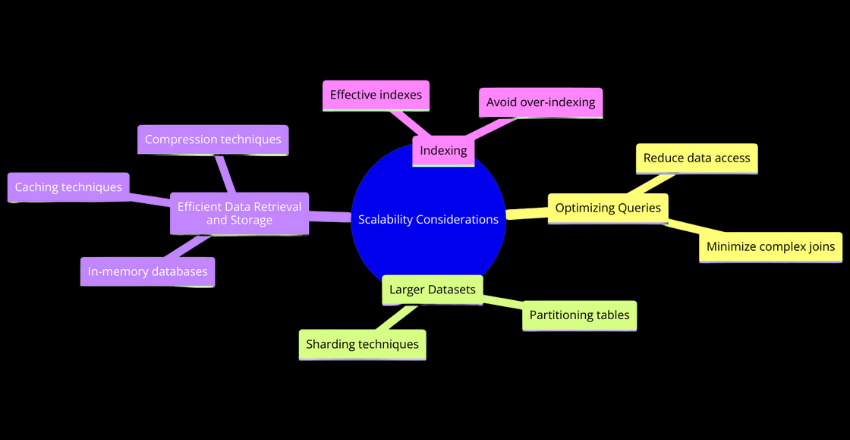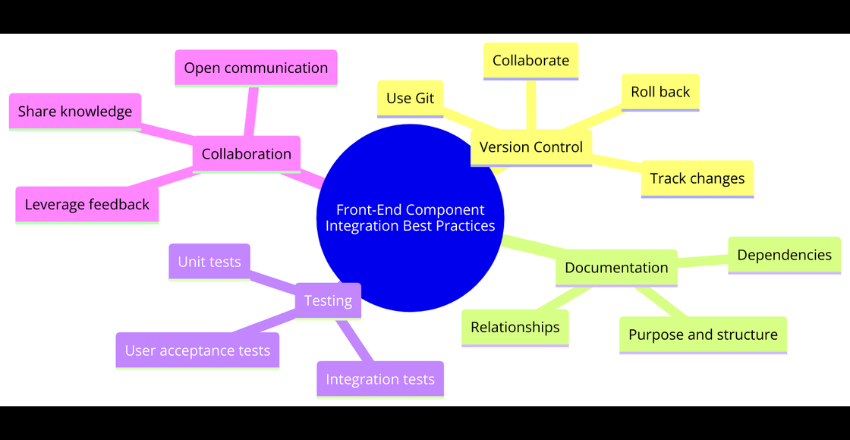
Database structures demystified front end components: Imagine a game where you build things. The part where you keep all your building blocks is like the database. The way you see and pick your blocks to build something cool is like the front-end. When both parts work really well together, playing the game becomes super fun and easy
Key Front-End Components
Front-end components are essential elements in database structures that play a significant role in defining data entry forms, user interfaces, and database interaction. These components allow users to input, manipulate, and retrieve data from the database.
Understanding the essential front-end components and how they fit together is crucial in building an effective database structure.
The main front-end components in a database structure include tables, forms, queries, and reports.
Tables are the fundamental building block of a database and are used to store and organize data into columns and rows. Forms provide an interface for users to input and modify data, while queries are used to retrieve specific data from the tables.
Reports, on the other hand, are used to summarize and present data from the tables in a formatted manner.
| Front-End Component | Description |
|---|---|
| Tables | The primary storage and organization of data in a database. |
| Forms | Provide an interface for users to input and modify data. |
| Queries | Retrieve specific data from tables. |
| Reports | Summarize and present data from tables in a formatted manner. |
These front-end components are interrelated and work together to form a cohesive system. For example, a form can be designed to input data into a table, and a query can be used to retrieve specific data from that table based on user input. Reports can then be generated from that data, providing a summary of the information in a formatted manner.
Understanding the role and purpose of these front-end components in database structures is essential in designing effective databases that are optimized for data entry, manipulation, and retrieval.
SQL Code Example
Here’s an example of how front-end components can be utilized in a database structure:
CREATE TABLE employees (
id INT NOT NULL,
name VARCHAR(255) NOT NULL,
age INT,
salary DECIMAL(10,2),
PRIMARY KEY (id)
);In this example, the “CREATE TABLE” statement is used to create a table named “employees” with four columns: “id,” “name,” “age,” and “salary.” The “id” column is set as the primary key, ensuring each row has a unique identifier. This table can then be utilized in a form for data entry and a query to retrieve specific data from the table based on user input.
Creating an Optimal Database Structure
Designing a well-structured database with front-end components is crucial for optimal database performance and scalability. Here are some important considerations to keep in mind:
- Normalization: Normalizing your database reduces redundancy and ensures data consistency, allowing for easier maintenance and updates.
- Indexing: Indexing columns that are frequently searched or sorted can significantly improve query performance.
- Standardization: Consistent naming conventions and data types across your database can improve data organization and ease of use.
- Query optimization: Writing efficient queries and avoiding unnecessary joins can help improve database performance.
Implementing these best practices ensures that your database is organized, efficient, and scalable. However, it is important to keep in mind that the structure of your database will depend on the specific needs of your application.
SQL Code Example
Here is an example of creating a table and a query in SQL:
| Code | Description |
|---|---|
| CREATE TABLE customers ( customer_id INT PRIMARY KEY, first_name VARCHAR(50), last_name VARCHAR(50), email VARCHAR(255) ); | Creates a table for storing customer information. |
| SELECT * FROM customers WHERE email LIKE ‘%@gmail.com’; | Retrieves all customer records with email addresses ending in ‘@gmail.com’. |
This example demonstrates the use of front-end components, such as tables and queries, to organize and retrieve data from a database.
Benefits of Well-Structured Front-End Components

Well-structured front-end components in a database can significantly improve database efficiency. Properly designed front-end components allow for improved data organization, streamlined data entry, and easier data retrieval.
One of the main benefits of well-structured front-end components is ease of use. By creating user-friendly interfaces, database developers can make it easier for end-users to enter and retrieve data. This can lead to increased productivity, as less time is spent on data entry and more time is spent on analyzing and utilizing the data.
Another advantage is better maintenance. Well-structured front-end components can make it easier to update and modify the database as needs change. This is especially important for databases with constantly changing data and requirements.
Finally, well-structured front-end components can improve scalability. By designing for scalability from the outset, developers can ensure that their databases can handle increased amounts of data and traffic without sacrificing performance.
SQL Code Example
To better understand the usage of front-end components in a database, let’s look at a practical SQL code example. Suppose we want to create a database for a bookstore, which stores information about books, authors, and publishers. We can start by creating the following tables:
| Table | Columns |
|---|---|
| books | id, title, author_id, publisher_id, published_date, price |
| authors | id, first_name, last_name, birth_date |
| publishers | id, name, established_date |
Next, we can define some queries to retrieve and manipulate data from these tables. For example, to get a list of all books and their authors sorted by title, we can use the following query:
SELECT books.title, authors.first_name, authors.last_name
FROM books
INNER JOIN authors ON books.author_id = authors.id
ORDER BY books.title;This query uses the SELECT statement to specify the columns we want to retrieve from the books and authors tables. The INNER JOIN clause is used to combine rows from both tables based on the author_id foreign key. Finally, the ORDER BY clause is used to sort the results by book title.
We can also generate reports based on the data in the database. For instance, we can create a report that shows the total number of books and the average price per publisher, using the following query:
SELECT publishers.name, COUNT(books.id) as total_books, AVG(books.price) as avg_price
FROM books
INNER JOIN publishers ON books.publisher_id = publishers.id
GROUP BY publishers.name;This query uses the GROUP BY clause to group the results by publisher name, and the COUNT and AVG functions to calculate the total number of books and the average price per publisher.
By using front-end components such as tables, forms, queries, and reports, we can create a database structure that efficiently stores and manages data, and enables us to retrieve and manipulate it in meaningful ways.
Common Challenges with Front-End Components

While front-end components can greatly enhance the usability and functionality of a database structure, they can also bring about their own set of challenges for developers.
It is important to be aware of these issues and take proactive measures to address them in order to ensure effective database management.
Some common challenges faced when working with front-end components include:
- Data Integrity: One of the key challenges faced when working with front-end components is maintaining data integrity. It is important to ensure that the data being entered into the system is accurate and valid through proper validation techniques.
- Security: As databases become more complex and hold sensitive information, security concerns become more prevalent. It is important to implement robust security measures to prevent unauthorized access.
- User Input Validation: Another challenge faced is ensuring that user inputs are correct and valid. This involves implementing validation checks to ensure the data entered is accurate and useful, enabling the system to provide meaningful results.
- Handling Errors: Inevitably, errors will occur when working with front-end components. Proper error handling techniques must be implemented to prevent data loss and ensure smooth user experience.
These challenges can be addressed through careful planning, design, and implementation. It is important to seek the assistance of experienced SQL professionals when developing and managing complex front-end components in a database structure in order to minimize potential errors and ensure optimal results.
Considerations for Scalability

When designing a database structure with front-end components, it’s important to consider scalability to ensure the system can handle increasing amounts of data and users without sacrificing performance or stability. Here are some key considerations to keep in mind:
Optimizing Queries
One of the main ways to improve scalability is to optimize queries. This involves reducing the amount of data accessed and processed by queries, as well as reducing complex joins or subqueries. By doing so, the database can process requests more quickly and efficiently, even as the amount of data grows.
Larger Datasets
As a database grows, it’s important to handle larger datasets by partitioning tables or using sharding techniques to distribute data across multiple servers. This helps distribute the processing load and ensures that queries run smoothly, even with a large amount of data.
Efficient Data Retrieval and Storage
Efficient data retrieval and storage are essential for maintaining scalability. One option is to use in-memory databases or caching techniques to store frequently accessed data, reducing the need for disk access and speeding up performance. Another option is to use compression techniques to reduce the amount of storage required for data.
Indexing
Indexing is another key consideration for scalability. By creating effective indexes, the database can quickly locate and retrieve data without scanning the entire table. However, it’s important to avoid over-indexing, which can impact performance and scalability.
SQL Code Example
Here is an example of SQL code that demonstrates how to create an index on a table:
CREATE INDEX idx_customers ON customers (last_name, first_name);This creates an index on the “customers” table based on the last name and first name fields. It can help improve query performance, particularly when searching for a specific customer by name.
Best Practices for Front-End Component Integration

When integrating front-end components into a database structure, it’s crucial to follow best practices to ensure optimal performance, scalability, and maintainability. Below are some key considerations for successful front-end component integration in database development.
Version Control
Version control is essential when working on any software project, including database development. Using a version control system such as Git allows you to track changes to your database structure and front-end components over time, collaborate with other developers, and easily roll back to previous versions if needed.
Documentation
Proper documentation is critical for maintaining and scaling database structures with front-end components. Documenting the purpose and structure of each component, as well as any dependencies or relationships, helps ensure clarity and accuracy for all members of the development team.
Testing
Thorough testing is crucial to ensure the functionality and compatibility of front-end components in a database structure. Performing unit tests, integration tests, and user acceptance tests helps detect and resolve any issues early in the development cycle, reducing the risk of errors and downtime.
Collaboration
Effective collaboration among developers is key to successful front-end component integration in database development. Encouraging open communication, sharing knowledge and insights, and leveraging team feedback can lead to more efficient and effective database structures.
SQL Code Example
Below is an example of SQL code for creating a basic front-end component in a database structure:
| Component | SQL Code |
|---|---|
| Table | CREATE TABLE Customers (CustomerID int, CustomerName varchar(255), ContactName varchar(255)); |
| Form | CREATE FORM CustomerForm; |
| Query | SELECT CustomerName, ContactName FROM Customers; |
| Report | CREATE REPORT CustomerReport; |
By following best practices and leveraging the appropriate tools and frameworks, developers can integrate front-end components into database structures efficiently and effectively. Consider partnering with HireSQL, an outsourcing company that provides dedicated SQL developers fluent in English, for expert guidance and support.
Tools and Resources for Front-End Database Development
Developing the front-end components of a database can be a complex process, but there are many tools and resources available to simplify and streamline the development process.
With these tools, developers can create more efficient and scalable database structures. Here are some development tools and frameworks worth considering:
- Bootstrap: This open-source front-end framework allows developers to easily create responsive, mobile-friendly user interfaces for their databases.
- jQuery: This fast and concise JavaScript library simplifies front-end development, making it easier to create dynamic web pages and user interfaces.
- MySQL Workbench: This visual database design tool simplifies database development and allows developers to create, manage, and optimize their databases from a single interface.
- Postman: This powerful HTTP client simplifies testing and debugging by allowing developers to quickly and easily test their front-end components.
There are also many online resources available for front-end database development, including user forums, documentation, and tutorials. With the right tools and resources, developers can create more efficient and user-friendly databases that meet the needs of their businesses and clients.
Final Thoughts

Understanding front-end components in database structures is essential for building efficient and scalable systems. By defining data entry forms, user interfaces, and interactions with the database, front-end components play a crucial role in the overall database architecture.
In order to create an optimal database structure, it is important to consider best practices and normalization techniques. Additionally, addressing common challenges such as data integrity and security is crucial when working with front-end components.
Despite these challenges, the benefits of well-structured front-end components are significant. With improved data organization, ease of use and maintenance, and the ability to adapt to changing requirements, a database with well-designed front-end components can greatly enhance database efficiency.
Tools and resources are available for front-end database development, including frameworks and applications that enable mobile compatibility, data visualization, and performance optimization.
External Resources
https://docs.commercetools.com/frontend-development/frontend-components
FAQ

FAQ 1: How do I ensure data integrity when displaying database content in front-end components?
Answer:
Ensuring data integrity involves validating and sanitizing data before it’s sent to the front end and correctly handling it in the front-end components. This process prevents displaying incorrect or malicious content to users.
Code Sample:
Back-End (Node.js/Express):
const express = require('express');
const app = express();
const sanitizeHtml = require('sanitize-html');
app.get('/api/data', async (req, res) => {
let rawData = await fetchDataFromDatabase(); // Fetch data from your database
let sanitizedData = sanitizeHtml(rawData, {
allowedTags: [], // Disallow all HTML tags to prevent XSS attacks
allowedAttributes: {} // No attributes allowed
});
res.json({ data: sanitizedData });
});Front-End (React):
import React, { useEffect, useState } from 'react';
import axios from 'axios';
function DataComponent() {
const [data, setData] = useState('');
useEffect(() => {
axios.get('/api/data')
.then(response => setData(response.data.data))
.catch(error => console.error('Error fetching data:', error));
}, []);
return <div>{data}</div>;
}
Explanation:
This example shows a Node.js/Express back-end sanitizing data fetched from a database before sending it to the front end. The React component then fetches this data and safely displays it. This approach ensures that any potential harmful content is neutralized before reaching the client side.
FAQ 2: How can I optimize front-end performance when dealing with large datasets?
Answer:
Optimizing front-end performance with large datasets involves implementing pagination or infinite scrolling to load data in chunks rather than all at once. This reduces the initial load time and improves the user experience.
Code Sample:
Back-End Pagination API:
app.get('/api/data', async (req, res) => {
const { page, pageSize } = req.query;
const data = await fetchPaginatedDataFromDatabase(page, pageSize);
// Implement pagination in your query
res.json(data);
});Front-End (React with Infinite Scrolling):
import React, { useState, useEffect } from 'react';
import axios from 'axios';
import InfiniteScroll from 'react-infinite-scroll-component';
function DataListComponent() {
const [items, setItems] = useState([]);
const [hasMore, setHasMore] = useState(true);
const [page, setPage] = useState(1);
useEffect(() => {
fetchMoreData();
}, []);
const fetchMoreData = () => {
axios.get(`/api/data?page=${page}&pageSize=20`)
.then(res => {
setItems(items.concat(res.data));
setPage(page + 1);
setHasMore(res.data.length > 0);
});
};
return (
<InfiniteScroll
dataLength={items.length}
next={fetchMoreData}
hasMore={hasMore}
loader={<h4>Loading...</h4>}
>
{items.map((item, index) => (
<div key={index}>{item.content}</div>
))}
</InfiniteScroll>
);
}Explanation:
This setup demonstrates a server-side pagination mechanism paired with a front-end implementation using React’s InfiniteScroll component. This approach ensures that the application only loads and renders a manageable subset of the total dataset at any given time, significantly enhancing performance.
FAQ 3: How do I maintain consistency between database structures and front-end models?
Answer:
Maintaining consistency involves using a schema or type system that is shared or replicated between the server and client. This ensures that both ends understand the data structure, reducing the risk of errors.
Code Sample:
Shared JSON Schema:
{
"type": "object",
"properties": {
"userId": { "type": "number" },
"userName": { "type": "string" },
"isActive": { "type": "boolean" }
},
"required": ["userId", "userName"]
}Back-End Validation (Node.js):
const Ajv = require('ajv');
const ajv = new Ajv();
const validate = ajv.compile(schema);
app.post('/api/user', (req, res) => {
const userData = req.body;
const valid =






